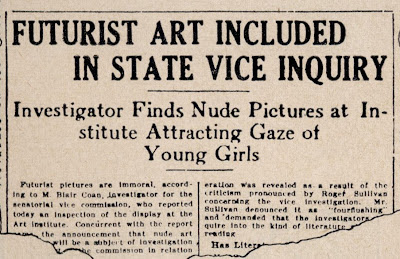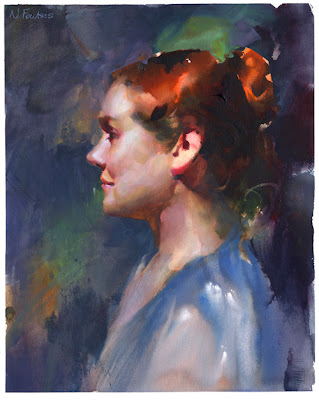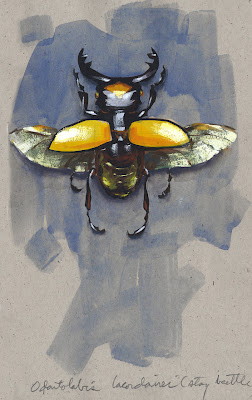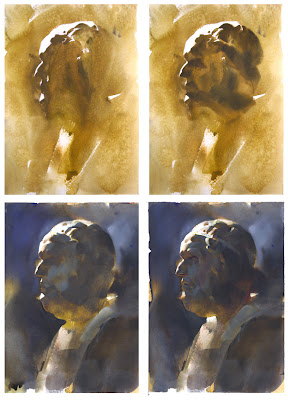. . . Fun with gouache. . . .
Posts
Showing posts from August, 2007
THE GAZE OF YOUNG GIRLS
- Get link
- Other Apps

In 1913, a pernicious little busybody named M. Blair Coan spied on visitors to an art exhibit in Chicago. Coan, an investigator for the State Vice Commission, was upset by the "immorality" of modern paintings and suspected that Matisse's painting of nude dancers might even be "attracting the gaze of young girls." Coan stirred up a great public outcry against immoral art. He then turned his talents to spreading alarm about the imminent communist takeover of the United States. In one of his books, The Coming Peril , Coan warned that socialism would ruin society by encouraging free love and giving women the right to vote. For Coan, the most "monstrously immoral" threat was that socialism might permit white women to consort with men of other races: The negro and the white woman, the white woman and the Chinaman, They draw no race line or color line in the [Socialist] party. Each new generation must battle its own versions of Coan. Personally, I wouldn'
ASHLEY WOOD'S TELEPHONE LINES
- Get link
- Other Apps

These pictures by illustrator Ashley Wood are a cross between drawing and knife fighting. Wood is one of those artists whose drawings benefit from controlled accidents. His slashing lines and spattered ink are part skill, part chance and part hydrological experiment. When you work that way, you can't be too picky about your materials. The reverse side of the above drawing shows how some of Wood's more fortunate accidents take place on stray scraps of paper: I like Wood's work. I like that he seems to draw on every available surface, from the backs of envelopes to waste paper, sometimes taping pages together when his experiment runs out of room. I find his emphasis on telephone lines in these drawings worth noting for two reasons. First, they show the importance of individual perception in composing an image. In most photographs, phone wires are so thin and insubstantial they don't even show up. In the following painting Edward Hopper ignores the phone wires: They are
THE BLACK AND WHITE OF COLOR
- Get link
- Other Apps

I recently posted some illustrations by the great watercolor artist John Gannam , who had an astute eye for color. But before he became famous for his use of color, Gannam did hundreds of black and white spot illustrations in the 1930s and 40s for lesser publications. Many artists treated such assignments as hack work to rush through. However, Gannam applied himself and learned valuable lessons from black and white pictures which served him well when he later painted color illustrations. Specifically, he learned from black and white illustrations to master value, which refers to the darkness or lightness of a color. Working in black and white, Gannam taught himself to control the "value structure" of his pictures, balancing blacks and whites and grays. He mastered tonality and contrast and learned to make his pictures eminently readable. I find Gannam's control over the value scale in pictures such as this one absolutely astounding: If you don't think this is hard
ARTISTS IN LOVE, part eleven
- Get link
- Other Apps

James Montgomery Flagg had an ugly view of beauty. "I have never had any slight interest in homely ladies," he said, "no matter how charming and intelligent they are reputed to be. They do not exist for me." And even if a woman satisfied his standards for beauty, she'd better not nag or be jealous about his many infidelities: [I]f I ran the world...I'd have my FBI corral all the ugly people [along with] all nagging and jealous women,...and take them out to Death Valley and drop an atomic bomb on them. He also believed that beauty, at least in women, diminished as they approached middle age: Usually former models of mine whom I don't see for a quarter of a century have become distinctly middle aged.... in an almost invariably shocking way....I occasionally tell these dames they look like zombies. They naturally resent it and usually come back with "Well, you don't look so hot yourself!" But that has no sting whatever.... Flagg never ran out
JAMES MONTGOMERY FLAGG
- Get link
- Other Apps

James Montgomery Flagg (1877-1960) drew the same way that he lived: brash and arrogant. Flagg's confidence was understandable. He worked at a time when illustrators were national celebrities. His famous poster, Uncle Sam Wants You , made him a household name. The press sought him out for his strong opinions. He consorted with hollywood stars, judged beauty contests, seduced young and impressionable models, frolicked at bohemian parties, and traveled back and forth to Europe with the beautiful people. I like his work a lot. My biggest complaint is that Flagg rarely let a single well-considered line suffice where five additional lines might fit: In this way, his style reflected his personality: never waste a minute reconsidering your initial line-- just keep underscoring it again and again. Flagg led a privileged life and had little understanding or sympathy for those who did not. He was a member of exclusive men's clubs from whose barricades he merrily indulged his sexist and


